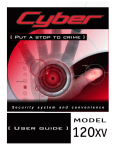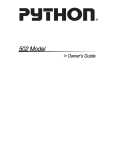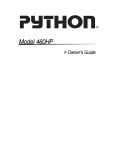Download Matrix 1
Transcript
Matrix 1
➤Owner’s Guide
limited lifetime consumer warranty
Directed Electronics, Inc. ("Directed®") promises to the original purchaser to repair or
replace with a comparable reconditioned model any Directed® unit (hereafter the "unit"),
excluding without limitation the siren, the remote transmitters, the associated sensors and
accessories, which proves to be defective in workmanship or material under reasonable use
during the lifetime of the vehicle provided the following conditions are met: the unit was
professionally installed and serviced by an authorized Directed® dealer; the unit will be
professionally reinstalled in the vehicle in which it was originally installed by an authorized Directed® dealer; and the unit is returned to Directed®, shipping prepaid with a legible copy of the bill of sale or other dated proof of purchase bearing the following information: consumer's name, telephone number and address; the authorized dealers name,
telephone number and address; complete product description, including accessories; the
year, make and model of the vehicle; vehicle license number and vehicle identification
number. All components other than the unit, including without limitation the siren, the
remote transmitters and the associated sensors and accessories, carry a one-year warranty
from the date of purchase of the same. This warranty is non-transferable and is automatically void if: the original purchaser has not completed the warranty card and mailed it
within ten (10) days of the date of purchase to the address listed on the card; the unit's
date code or serial number is defaced, missing or altered; the unit has been modified or
used in a manner contrary to its intended purpose; the unit has been damaged by accident, unreasonable use, neglect, improper service, installation or other causes not arising
out of defects in materials or construction. The warranty does not cover damage to the
unit caused by installation or removal of the unit. Directed®, in its sole discretion, will
determine what constitutes excessive damage and may refuse the return of any unit with
excessive damage. TO THE MAXIMUM EXTENT ALLOWED BY LAW, ALL WARRANTIES, INCLUDING BUT NOT LIMITED TO EXPRESS WARRANTY, IMPLIED WARRANTY, WARRANTY OF MERCHANTABILITY, FITNESS FOR PARTICULAR PURPOSE AND WARRANTY OF NON-INFRINGEMENT OF INTELLECTUAL PROPERTY, ARE EXPRESSLY EXCLUDED; AND Directed® NEITHER
ASSUMES NOR AUTHORIZES ANY PERSON OR ENTITY TO ASSUME FOR IT ANY DUTY, OBLIGATION OR LIABILITY IN CONNECTION WITH ITS PRODUCTS. DIRECTED® DISCLAIMS AND
HAS ABSOLUTELY NO LIABILITY FOR ANY AND ALL ACTS OF THIRD PARTIES INCLUDING ITS
AUTHORIZED DEALERS OR INSTALLERS. DIRECTED® SECURITY SYSTEMS, INCLUDING THIS
UNIT, ARE DETERRENTS AGAINST POSSIBLE THEFT. DIRECTED® IS NOT OFFERING A GUARANTEE OR INSURANCE AGAINST VANDALISM, DAMAGE OR THEFT OF THE AUTOMOBILE, ITS
PARTS OR CONTENTS; AND HEREBY EXPRESSLY DISCLAIMS ANY LIABILITY WHATSOEVER,
INCLUDING WITHOUT LIMITATION, LIABILITY FOR THEFT, DAMAGE AND/OR VANDALISM.
THIS WARRANTY DOES NOT COVER LABOR COSTS FOR MAINTENANCE, REMOVAL OR REINSTALLATION OF THE UNIT OR ANY CONSEQUENTIAL DAMAGES OF ANY KIND. IN THE EVENT
OF A CLAIM OR A DISPUTE INVOLVING DIRECTED® OR ITS SUBSIDIARY, THE PROPER VENUE
SHALL BE SAN DIEGO COUNTY IN THE STATE OF CALIFORNIA. CALIFORNIA STATE LAWS AND
© 2001 directed electronics, inc.
i
APPLICABLE FEDERAL LAWS SHALL APPLY AND GOVERN THE DISPUTE. THE MAXIMUM
RECOVERY UNDER ANY CLAIM AGAINST DIRECTED® SHALL BE STRICTLY LIMITED TO THE
AUTHORIZED DIRECTED® DEALER'S PURCHASE PRICE OF THE UNIT. DIRECTED® SHALL NOT
BE RESPONSIBLE FOR ANY DAMAGES WHATSOEVER, INCLUDING BUT NOT LIMITED TO, ANY
CONSEQUENTIAL DAMAGES, INCIDENTAL DAMAGES, DAMAGES FOR THE LOSS OF TIME,
LOSS OF EARNINGS, COMMERCIAL LOSS, LOSS OF ECONOMIC OPPORTUNITY AND THE LIKE.
NOTWITHSTANDING THE ABOVE, THE MANUFACTURER DOES OFFER A LIMITED WARRANTY TO REPLACE OR REPAIR THE CONTROL MODULE AS DESCRIBED ABOVE. Some states do
not allow limitations on how long an implied warranty will last or the exclusion or limitation of incidental or consequential damages. This warranty gives you specific legal rights
and you may also have other rights that vary from State to State.
This product may be covered by an Anti-Theft Guarantee. See your authorized Directed®
dealer for details of the plan or call Directed® Customer Service at 1-800-876-0800.
Directed® security systems, including this unit, are deterrents against possible theft.
Directed® is not offering a guarantee or insurance against vandalism, damage or theft of
the automobile, its parts or contents; and hereby expressly disclaims any liability whatsoever, including without limitation, liability for theft, damage and/or vandalism. Directed®
does not and has not authorized any person or entity to create for it any other obligation,
promise, duty or obligation in connection with this security system.
Make sure you have all of the following information from your dealer:
A clear copy of the sales receipt, showing the following:
➤
➤
➤
➤
➤
➤
➤
➤
➤
Date of purchase
Your full name and address
Authorized dealer's company name and address
Type of alarm installed
Year, make, model and color of the automobile
Automobile license number
Vehicle identification number
All security options installed on automobile
Installation receipts
trademarks and copyrights
Bitwriter™, Clifford®, Code-Hopping™, DEI®, Directed®, Doubleguard®, ESP™, FailSafe®,
Ghost Switch™, Learn Routine™, Nite-Lite®, Nuisance Prevention Circuitry®, NPC®,
Revenger®, Silent Mode™, Soft Chirp®, Stealth Coding™, Stinger®, Valet®, Vehicle
Recovery System®, VRS®, and Warn Away® are all Trademarks or Registered Trademarks
of Directed Electronics, Inc.
ii
© 2001 directed electronics, inc.
table of contents
Limited Lifetime Consumer Warranty . . . . . . . . . . . . . . . . . . . . . . . . . . . . . . . . . . . i
What Is Included . . . . . . . . . . . . . . . . . . . . . . . . . . . . . . . . . . . . . . . . . . . . . . . . . . 2
Important Information . . . . . . . . . . . . . . . . . . . . . . . . . . . . . . . . . . . . . . . . . . . . . . 2
System Maintenance . . . . . . . . . . . . . . . . . . . . . . . . . . . . . . . . . . . . . . . . . . . . 3
Your Warranty . . . . . . . . . . . . . . . . . . . . . . . . . . . . . . . . . . . . . . . . . . . . . . . . 3
FCC/ID Notice. . . . . . . . . . . . . . . . . . . . . . . . . . . . . . . . . . . . . . . . . . . . . . . . 3
Transmitter Functions . . . . . . . . . . . . . . . . . . . . . . . . . . . . . . . . . . . . . . . . . . . . . . 4
Standard Configuration . . . . . . . . . . . . . . . . . . . . . . . . . . . . . . . . . . . . . . . . . . 4
Using Your System . . . . . . . . . . . . . . . . . . . . . . . . . . . . . . . . . . . . . . . . . . . . . . . . 5
Arming . . . . . . . . . . . . . . . . . . . . . . . . . . . . . . . . . . . . . . . . . . . . . . . . . . . . . 5
Multi-Level Security Arming (Optional Feature) . . . . . . . . . . . . . . . . . . . . . . . . 7
Arming While Driving . . . . . . . . . . . . . . . . . . . . . . . . . . . . . . . . . . . . . . . . . . 8
Disarming . . . . . . . . . . . . . . . . . . . . . . . . . . . . . . . . . . . . . . . . . . . . . . . . . . . 8
Siren Silencing . . . . . . . . . . . . . . . . . . . . . . . . . . . . . . . . . . . . . . . . . . . . . . . . 9
Disarming Without a Transmitter. . . . . . . . . . . . . . . . . . . . . . . . . . . . . . . . . . . 9
Remote Controlled Chirp Muting . . . . . . . . . . . . . . . . . . . . . . . . . . . . . . . . . 10
Panic Mode . . . . . . . . . . . . . . . . . . . . . . . . . . . . . . . . . . . . . . . . . . . . . . . . . . 10
Valet Mode . . . . . . . . . . . . . . . . . . . . . . . . . . . . . . . . . . . . . . . . . . . . . . . . . 11
Remote Controlled Valet Mode . . . . . . . . . . . . . . . . . . . . . . . . . . . . . . . . . . . 11
False Alarm Control Technology (FACT) . . . . . . . . . . . . . . . . . . . . . . . . . . . . 12
Diagnostics . . . . . . . . . . . . . . . . . . . . . . . . . . . . . . . . . . . . . . . . . . . . . . . . . . . . . 13
Arming Diagnostics . . . . . . . . . . . . . . . . . . . . . . . . . . . . . . . . . . . . . . . . . . . . 13
Disarming Diagnostics. . . . . . . . . . . . . . . . . . . . . . . . . . . . . . . . . . . . . . . . . . 14
Table of Zones. . . . . . . . . . . . . . . . . . . . . . . . . . . . . . . . . . . . . . . . . . . . . . . . 14
Anti-C
Code Grabbing (ACG) . . . . . . . . . . . . . . . . . . . . . . . . . . . . . . . . . . . . . . . . . 15
High Frequency . . . . . . . . . . . . . . . . . . . . . . . . . . . . . . . . . . . . . . . . . . . . . . . . . . 16
Owner Recognition . . . . . . . . . . . . . . . . . . . . . . . . . . . . . . . . . . . . . . . . . . . . . . . 16
Smart Power Up II . . . . . . . . . . . . . . . . . . . . . . . . . . . . . . . . . . . . . . . . . . . . . . . 17
Power Saver Mode . . . . . . . . . . . . . . . . . . . . . . . . . . . . . . . . . . . . . . . . . . . . . . . . 17
Programming Options . . . . . . . . . . . . . . . . . . . . . . . . . . . . . . . . . . . . . . . . . . . . . 18
Installation Options . . . . . . . . . . . . . . . . . . . . . . . . . . . . . . . . . . . . . . . . . . . . . . . 21
Vehicle Recovery System (VRS) . . . . . . . . . . . . . . . . . . . . . . . . . . . . . . . . . . . . . . 22
Arming the VRS . . . . . . . . . . . . . . . . . . . . . . . . . . . . . . . . . . . . . . . . . . . . . . 23
VRS Triggered Sequence . . . . . . . . . . . . . . . . . . . . . . . . . . . . . . . . . . . . . . . . 24
Disarming the VRS . . . . . . . . . . . . . . . . . . . . . . . . . . . . . . . . . . . . . . . . . . . 25
Glossary Of Terms . . . . . . . . . . . . . . . . . . . . . . . . . . . . . . . . . . . . . . . . . . . . . . . . 26
Security & Convenience Expansions . . . . . . . . . . . . . . . . . . . . . . . . . . . . . . . . . . . 28
Quick Reference Guide (Removable) . . . . . . . . . . . . . . . . . . . . . . . . . . . . . . . . . . 30
© 2001 directed electronics, inc.
1
what is included
➤
A control module
➤
A pair of 3-button transmitters
➤
An XHF receiver/antenna
➤
A shock sensor (on-board the alarm module)
➤
A siren
➤
A red LED status indicator light
➤
A push-button Valet switch
➤
Your warranty registration
➤
Fault-proof starter interrupt ready circuitry (may require
additional labor)
important information
Congratulations on the purchase of your state-of-the-art vehicle
security system. It has been designed to provide years of troublefree operation. This system must be installed by an authorized
dealer. Installation of this product by anyone other than an
authorized dealer voids the warranty. As verification of
authorization, all authorized dealers are provided with
preprinted dealer certificates.
In order to maximize the use of this system, please review this
owner's guide carefully prior to using your system. You can print
additional or replacement copies of this owner’s guide by
accessing the Clifford website at www.clifford.com.
2
© 2001 directed electronics, inc.
➜ system maintenance
The system requires no specific maintenance. Your remote
control is powered by a miniature 3V lithium battery that will
last approximately one year under normal use. When the battery
weakens, operating range will be reduced and the LED on the
remote will dim.
➜ your warranty
Your warranty registration must be completely filled out and
returned within 10 days of purchase. Your product warranty
will not be validated if your warranty registration is not returned.
Make sure you receive the warranty registration from your
dealer. It is also necessary to keep your proof of purchase, which
reflects that the product was installed by an authorized dealer.
➜ fcc/id notice
This device complies with Part 15 of FCC rules. Operation is
subject to the following two conditions: (1) This device may not
cause harmful interference, and (2) This device must accept any
interference received, including interference that may cause
undesired operation.
Changes or modifications not expressly approved by the party
responsible for compliance could void the user's authority to
operate this device.
© 2001 directed electronics, inc.
3
transmitter functions
The receiver uses computer-based code learning to learn the
transmitter buttons. This makes it possible to assign any transmitter button to any receiver function. The transmitter initially
comes programmed with standard configuration, but may also
be customized by an authorized dealer. The buttons in all of the
instructions in this manual correspond to a standard configuration
transmitter.
➜ standard configuration
Button
The arming, disarming and panic function are usually controlled
by this button.
Button
Remote Controlled Chirp Muting and an optional accessory
function are controlled by
. (Remote Controlled Chirp
Muting works by pressing
for less than one second before
arming or disarming the system. An optional accessory function,
such as trunk release, can be controlled by pressing
for 1.5
seconds.) This accessory output controls __________________.
Button
An optional accessory convenience or expansion function that
you have added to your system can be activated by pressing
. This accessory output controls ___________________.
4
© 2001 directed electronics, inc.
using your system
The buttons used in the instructions in this manual correspond
to the standard transmitter configuration. If your transmitter has
been custom configured, the icons on your transmitter buttons
may not correspond to the indicated functions.
➜ arming
You can activate, or arm, the system by pressing
on your
transmitter for one second. When the system arms, you will hear
a short siren sound, or chirp, and see the parking lights flash
once. If the vehicle’s power door locks have been connected to the
system, the doors will lock.
While the system is armed, the LED status indicator will flash
approximately once per second, showing that the system is
actively protecting your vehicle. If you hear a second chirp after
arming, and see the LED status indicator flashing in groups, refer
to the Diagnostics section of this guide. This extra chirp is called
Bypass Notification.
The security system also can be programmed to arm itself
automatically (called passive arming). If the system is
programmed for passive arming, it will automatically arm 30
seconds after the ignition is turned off and the system "sees" you
leave the vehicle by opening and closing a door. Whenever the
system is in its 30-second passive-arming countdown, the LED
status indicator will flash twice as fast as it does when the system
© 2001 directed electronics, inc.
5
is armed. The siren will chirp once 20 seconds after the last door
has been closed. The system is not actually armed at that point.
The system arms and the doors lock (if connected and
programmed for passive locking) at 30 seconds, but the siren will
not chirp. The early chirp provides you with a 10-second
warning prior to arming.
note: If any protected entry point (such as a door or a switchprotected trunk or hood) is open, the system will not
passively arm (unless forced passive arming is programmed
on.) See Programming Options section of this guide.
Additionally, each time a sensor is triggered during the
arming countdown, the 30-second countdown starts over.
When armed, your vehicle is protected as follows:
➤
Light impacts will trigger the Warning Zone signal. When
triggered, the siren will chirp and the parking lights will flash
for a few seconds.
➤
Heavy impacts will trigger the system. The triggered
sequence is between 1-180 seconds of constant siren and
flashing parking lights.
➤
If a door is opened, the system will immediately start
chirping the siren and flashing the parking lights. Three
seconds later, the siren output changes to a continuous blast.
This progressive response gives you time to disarm the system with your transmitter if you inadvertently open the door
while the system is armed, while still providing an instant
response (even if the door is immediately closed).
6
© 2001 directed electronics, inc.
➤
Turning on the ignition key will trip the same two-stage
response as opening a door.
➤
The optional starter interrupt prevents the vehicle’s starter
from cranking.
➜ multi-level security arming (optional feature)
note: Multi-Level Security Arming is only available when
using an optional 4-button Radar Master transmitter that
has been configured with separate transmitter buttons for
arming and disarming.
Multi-Level Security Arming allows you to select which of the
security system's inputs or sensors will be active and which will
be bypassed at the time that the system is armed. (See Table of
Zones section.) Pressing the arm button again within five seconds
of arming the security system will activate the Multi-Level
Security Arming feature. Each time the arm button is pressed
again, a different security level is selected. The different security
levels can be selected as follows:
➤
Pressing the arm button one time: The siren chirps once. The
system is armed.
➤
Pressing the arm button a second time within five seconds:
The siren chirps twice followed by a long chirp. Zone Two is
now bypassed.
➤
Pressing the arm button a third time within five seconds: The
siren chirps three times followed by a long chirp. Zone Four
is now bypassed.
© 2001 directed electronics, inc.
7
➤
Pressing the arm button a fourth time within five seconds:
The siren chirps four times followed by a long chirp. Zones
Two and Four are now bypassed.
➤
Pressing the arm button a fifth time within five seconds: The
siren chirps five times followed by a long chirp. All input
zones, except the ignition, are now bypassed.
note: Multi-Level Security Arming only applies to a single arming cycle. Once the system is disarmed and then
re-armed, all the zones will be active again.
➜ arming while driving
Your system can be armed while driving the vehicle! Simply press
on your transmitter for 1.5 seconds while the vehicle is
running, or the ignition is on. The system will chirp once and
then once more to indicate that the ignition is on. The system
will not respond to any input except the door triggers and the
starter interrupt relay (if installed) will not be activated. The
system will disarm automatically when the ignition is turned off.
The siren will chirp twice and the LED will stop flashing.
note: If programmed for the optional Vehicle Recovery
System (VRS) feature, arming with the transmitter will
arm the VRS feature. (See VRS section of this guide.)
➜ disarming
To disarm the system, press
. You will hear two chirps, and
the parking lights will flash twice. If the power locks are
8
© 2001 directed electronics, inc.
connected to the system, the doors will unlock. If the siren chirps
either four or five times when disarming, refer to the Diagnostics
section of this guide. This is called Tamper Alert.
➜ siren silencing
This system proudly offers Siren Silencing. Siren Silencing is a
feature that makes it possible to silence and reset the system
when it is triggering without disarming the system. If the system
is triggered, and the siren has been sounding for longer than six
seconds, pressing
on the transmitter will stop the trigger
and return the unit to the armed state. The system will not
disarm, but rather reset. This prevents you from disabling the
system should you wish to disarm it without visually checking
the vehicle. Pressing the disarm button again, after resetting the
system, will disarm the system. Pressing
during the first
six seconds of the triggered sequence will disarm the system
immediately. The six second timer is provided for your convenience, in case you accidentally trigger the system.
➜ disarming without a transmitter
This feature allows you to disarm the system without the transmitter should it be lost, damaged or disabled. In order to disarm
without a transmitter, you must have the vehicle’s ignition key
and know where the Valet switch is located. Be sure to check
with the installer for the location of the Valet switch.
© 2001 directed electronics, inc.
9
To disarm the security system, turn
the ignition to the "on" position.
Press the Valet switch the preset
DRW-35
number of times (1-5 times) within 15 seconds. After 1.5
seconds the system should disarm. If it does not, you may have
waited too long; turn the ignition off and on and try again.
important! The unit can be programmed to respond to 1-5
pulses of the Valet switch for the disarm function. Be sure
to check with the installer for the desired programming.
Location of Valet Switch_________________________________
➜ remote controlled chirp muting
To temporarily turn off the arm or disarm chirps, use Remote
Controlled Chirp Muting. Simply press
on the trans-
mitter briefly before arming or disarming, and the confirmation
chirp(s) will be eliminated for that one operation only. If you
want the arm/disarm chirps turned off permanently, your dealer
can do this for you.
note: The Warning Zone response to lighter impacts is
bypassed if the system is armed using Remote Controlled
Chirp Muting. This ensures that no chirps will be emitted by the siren in an area you want chirp-free. The system is still fully capable of triggering. Only the Warning
Zone response is bypassed.
➜ panic mode
If you are threatened in or near your vehicle, you can attract
attention by triggering the system with your transmitter! Just
10
© 2001 directed electronics, inc.
press
for 1.5 seconds, and you will enter Panic Mode. The
siren will sound and the parking lights will flash for the
programmed siren duration. To stop Panic Mode at any time,
press
on the remote transmitter again.
➜ valet mode
You can prevent your security system from automatically arming
and triggering by using Valet Mode. This is very useful when
washing the vehicle or having it serviced. In Valet Mode, the
security system will not arm, even with the remote transmitter,
but all convenience functions (door locks, trunk release, etc.)
will continue to work normally.
To enter or exit Valet Mode:
1. Turn the ignition on.
2. Turn the ignition off.
3. Press and release the Valet
DRW-35
switch within 10 seconds.
The LED status indicator will light steadily if you are entering
Valet Mode and will turn off if you are exiting Valet Mode.
➜ remote controlled valet mode
The operations described in this section refer to transmitter
buttons. Remember, the buttons used in all the instructions in
this guide correspond to a Standard Configuration transmitter.
This may not be how your transmitter is set up.
© 2001 directed electronics, inc.
11
1. Open any vehicle door.
2. Press
.
3. Press
.
4. Press
again.
The LED status indicator will light solid if you are entering Valet
Mode, or will go out if you are exiting Valet Mode.
➜ false alarm control technology (FACT)
Your system offers FACT, a feature that prevents annoying
repetitive trigger sequences due to a faulty sensor or environmental conditions such as thunder, jackhammers, airport noise, etc.
Here’s how it works: The alarm triggers three times. Each time,
the same sensor is triggering the alarm. The three triggers are
within 60 minutes of each other. FACT will interpret this
pattern of triggers as false alarms. After the third trigger, FACT
ignores, or bypasses, that sensor (along with any other sensors
sharing the same zone) for 60 minutes.
If the bypassed sensor tries to trigger the system while it is being
bypassed, the 60-minute bypass period will start over. This
ensures that a sensor that continually triggers will remain
bypassed.
Doors are covered by FACT differently: If the alarm is triggered
by an open door for three full cycles, the doors will be bypassed
until the trigger ceases.
12
© 2001 directed electronics, inc.
FACT is programmable. See the Programming Options section
of this guide.
note: Arming and disarming the system does not reset
this function! The only ways to reset a bypassed zone are
for it to not trigger for 60 minutes, or to turn on the ignition. If testing your system, it is important to remember
that the FACT programming can cause zones to be
bypassed and appear to stop working. If five chirps are
heard when disarming, FACT has been engaged. If you
wish to clear the FACT memory, turn the ignition key on.
diagnostics
The microprocessor at the heart of your security system is
constantly monitoring all of the switches and sensors that are
connected to it. It detects any faulty switches and sensors and
prevents them from disabling the entire system. The microprocessor will also record and report any triggers that occurred
during your absence.
➜ arming diagnostics
If the system is armed while an input is active (door open, sensor
triggering, etc.) the unit will chirp once when arming and then
one more time a few seconds later. This is called Bypass Notification.
note: Bypass Notification will not occur when using
Remote Controlled Chirp Muting or if chirps have been
programmed OFF.
© 2001 directed electronics, inc.
13
The security system will ignore the input that was active when
the system was armed, until the input goes away. Three seconds
later the system will monitor that input normally. For example,
if your vehicle has interior light exit delay, and you arm the
system before the interior light goes out, you may hear Bypass
Notification chirps. Once the light shuts off, however, the doors
are monitored normally.
➜ disarming diagnostics
Extra disarm chirps are the Tamper Alert. If four chirps are heard
when disarming, the system was triggered in your absence. If five
chirps are heard, a zone was triggered so many times that
False Alarm Control Technology (FACT) has bypassed that zone.
In either case, the LED status indicator will indicate which zone
was involved (see Table of Zones section). The system will retain
this information in its memory, and continue to chirp four or
five times each time it is disarmed, until the next time the ignition key is turned on.
➜ table of zones
The zone number is the number of LED flashes used by the
system to identify a specific input. The standard input assignments are listed below, along with spaces to write in any optional
sensors or switches you have had installed.
14
© 2001 directed electronics, inc.
Zone - Number
of LED Flashes
Description
Dealer-Installed
Options
1
Instant trigger - often used
for hood/trunk pinswitches
2
Instant trigger - a heavier impact
detected by the shock sensor
3
Door switch trigger
4
Instant trigger - for optional sensors
5
Ignition trigger
If the Warning Zone response is triggered, the LED will not report
it.
note: Your system stores the last two triggered zones in
memory. If your system has been triggered but the LED
has been reset by turning on the ignition, your dealer can
still recall the last two zones that were triggered. Contact
your dealer for details.
anti-ccode grabbing (ACG)
This unit features Anti-Code Grabbing (ACG) with Random
Code Encryption. This means the receiver and transmitters each
use a mathematical formula called an algorithm to change their
code each time the transmitter is used. This technology has been
developed to increase the security of the unit. The control unit
knows what the next codes should be. This helps to keep the
transmitter "in sync" with the control unit even if you use the
© 2001 directed electronics, inc.
15
remote control out of range of the vehicle. However, if the transmitter has been pressed many times out of range of the vehicle,
or the battery has been removed, it may get out of sync with the
control unit and fail to operate the system. To re-sync the remote
control simply press
of the transmitter several times
within range of the vehicle. The alarm will automatically re-sync
and respond to the transmitters normally.
high frequency
Your system transmits and receives at 433 MHz. This provides a
cleaner spectrum with less interference and a more stable signal.
Enjoy a phenomenal increase in range – even in areas with high
radio interference.
owner recognition
Owner Recognition is a feature available exclusively from
Directed®. Using a Directed® Bitwriter, hand-held programming
tool, your dealer can program many of the system settings. The
programmer makes it possible to program different settings for
each transmitter that is used with the system. Then, whenever a
specific transmitter is used, the system will recall the settings
assigned to that transmitter. Owner Recognition lets up to four
users of the system have different settings that meet their specific
16
© 2001 directed electronics, inc.
needs. It is almost like having four separate alarms in your
vehicle, one for each user.
note: Owner Recognition cannot be programmed without a Bitwriter and the necessary software. Check with
your dealer for more information.
smart power up II
This security system will store its current state to non-volatile
memory. If power is lost and then reconnected the system will
recall the stored state from memory. This means if the unit is in
Valet Mode and the battery is disconnected for any reason, such
as servicing the car, when the battery is reconnected the unit will
still be in Valet Mode. This applies to all states of the system
including arm, disarm, VRS, and Valet Mode.
power saver mode
Your system will automatically enter Power Saver Mode while
armed or in Valet Mode, after a period of time in which no operation has been performed. This lowers the current draw on the
vehicle's battery and prevents the system from draining the
battery. Power Saver Mode takes over under the following conditions:
© 2001 directed electronics, inc.
17
➤
Power Saver when the system is armed: After the system has
been armed for 24 hours, the LED will flash at half its
normal rate, decreasing the system's current draw.
➤
Power Saver in Valet Mode: When the system enters Valet
Mode the LED illuminates steadily. If the vehicle is not used
(ignition is not turned on) for a period of one hour while the
system is in Valet Mode, the LED will shut off. If the system
remains in Valet Mode, the LED will come back on the next
time the ignition is turned on and then back off.
programming options
Programming options control what your system does during
normal operation, and require few or no additional parts.
However, some may require additional installation labor.
The following is a list of the program settings, with the factory
settings in bold:
➤
Active arming (only with the transmitter) or passive arming
(automatic arming 30-seconds after the last door is closed).
If programmed for passive arming, a feature called Smart
Relocking will occur when the system is disarmed without
opening a door, so that the doors will automatically lock
when the system passively rearms.
18
➤
Arming/disarming confirmation siren chirps on or off.
➤
Auto-Lock/Auto-Unlock on or off: With this feature on, the
© 2001 directed electronics, inc.
doors will lock three seconds after the ignition is turned on,
and unlock when the ignition is turned off. If your installer
is programming the security system with the Directed®
Bitwriter or a personal computer and the TechSoft
Programmer, ignition lock and unlock are independent
features and can be programmed separately.
➤
Passive door locking (with passive arming) or active door
locking (only when arming with the transmitter). Passive
locking allows the vehicle's doors to lock when the security
system passively arms (after the 30 second countdown). This
feature only works if passive arming has been programmed.
➤
Panic mode enabled/disabled with the ignition on: Some
states have laws against siren capability in a moving vehicle.
➤
Forced passive arming on or off: If your security system is
programmed for passive arming and the forced passive arming
feature has been programmed on, the system will passively
arm after one hour, even if a protected entry has been left
open. This feature is useful if a vehicle door has been left ajar
when leaving the vehicle. Forced passive arming ensures that
the security system will be armed in every situation.
note: When the system passively arms after one hour, the
entry point that has been left open, and anything connected to the same zone, is bypassed and cannot trigger
the system. However, the remaining inputs to the system
are fully operational.
➤
Automatic Engine Disable (AED) on or off: The purpose of
this feature is to protect the vehicle from being stolen at all
© 2001 directed electronics, inc.
19
times, regardless of whether or not the alarm is armed. If
AED is programmed on, the starter of the vehicle will be disabled 30 seconds after the ignition is turned off. Once the
key is turned off, the LED will flash slowly (one-half its
normal armed rate) to indicate the AED arming cycle.
Thirty seconds later, the starter of the vehicle will be disabled. To start the car, it will be necessary to arm the car with
the remote and then disarm it with the remote. It is also
possible to disarm the AED feature by turning the ignition
key to the "run" position and pressing the Valet switch the
programmed number of times. AED is disabled when the
system is in Valet Mode.
note: This feature will only function if the starter interrupt relay has been installed.
➤
Full trigger response 30 or 60 seconds: This determines how
long the full triggered sequence lasts. Some states have laws
regulating how long a security system can sound before it is
considered a nuisance. If your installer is programming the
security system with the Directed® Bitwriter or a personal
computer and the TechSoft Programmer, the full triggered
response can be programmed for any duration ranging from
1 to 180 seconds.
➤
False Alarm Control Technology (FACT) on or off: Please refer
to the FACT section of this guide for a complete explanation
of how FACT operates. If FACT is programmed off, the security
system will respond to inputs from any sensor indefinitely.
20
© 2001 directed electronics, inc.
note: Because many states have laws regulating security
systems, programming FACT off may cause your system
to violate state laws.
➤
Progressive door trigger on or off: When the system is armed
and a door is opened, the system responds with ten chirps
prior to beginning the full triggered sequence. If an instant
trigger is desired, the progressive door trigger can be programmed off.
➤
Valet pulse count: The number of Valet switch presses required
to disarm the security system or the VRS can be programmed
from one to five presses. The default setting is one press.
➤
Siren tones and chirp volume: The output of the siren
consists of six different tones in sequence. Any of these tones
can be eliminated by your dealer, resulting in a unique, easily
identifiable siren sound. The siren chirps can be either full
volume or 6 decibels quieter than the full alarm blast.
installation options
The system has many options that may require extra parts and
labor. A few of the options are listed below:
➤
Progressive Unlocking: In most cars with electric power door
locks, the system can be configured so that when disarmed,
only the driver’s door unlocks. A second press of the disarm
button within 15 seconds of disarming unlocks the other doors.
© 2001 directed electronics, inc.
21
➤
Vehicle Recovery System (VRS): VRS is an anti-carjacking
device designed to help in the safe recovery of your vehicle
in case of a carjacking. Please refer to the Vehicle Recovery
System section of this manual for a complete explanation of
how the Vehicle Recovery System operates.
vehicle recovery system (VRS)
The optional VRS feature is designed to ensure that any unauthorized user of your vehicle (even if using your keys and remote
control) will not be able to permanently separate you from your
vehicle.
The VRS cannot prevent a carjacking attempt, however, it does
ensure that if your vehicle is taken by an unauthorized user, it
will be disabled (after several progressive warnings) as safely as
possible. Should a carjacking occur, the VRS allows you to
concern yourself with your personal safety without worrying
about your property.
Directed® has engineered this vehicle security system, the starter
interrupt, and the VRS feature to provide the best combination
of personal safety and property protection available. When properly installed, the system can never inadvertently stop your
vehicle in traffic or on railroad tracks while the vehicle is in operation. It is unlike other systems that shut down your engine
while it is running. This system is designed to perform starter in22
© 2001 directed electronics, inc.
terrupt. The starter interrupt cannot shut down an alreadyrunning engine – it can only prevent an engine from starting in
the first place.
Any installation which allows this product to shut down a
vehicle's engine when it is running is contrary to the product’s
design and intended usage, and Directed® hereby expressly disclaims any liability resulting therefrom.
➜ arming the VRS
To arm the VRS, turn the ignition to the ON position and press
on the remote transmitter for one second. The parking
lights will flash and the siren will chirp once. This can be done
before driving or while driving the vehicle. Once the system is
armed, it will initiate its triggered sequence (see the following
section) if any door is opened and closed. If you are forced from
the vehicle, the system will trigger as the door is opened and
closed. This is how the system works to combat intersection
carjacking.
To protect against parking lot carjacking, arm the VRS before
leaving the vehicle. The system will now trigger automatically
the next time you or anyone drives the vehicle. This helps to
protect the vehicle if someone takes your keys and remote transmitter by force in a parking lot.
© 2001 directed electronics, inc.
23
note: If the VRS system is armed while operating the
vehicle and not disarmed prior to leaving the vehicle, it is
still armed and will trigger the next time the vehicle is driven.
➜ VRS triggered sequence
Fifteen seconds after the last door has closed, the system’s LED
status indicator will begin flashing. This delay is intended to
allow you time to distance yourself from your vehicle in the
event of a carjacking.
Forty-five seconds later, the siren begins chirping and the park-
ing lights begin flashing. This time could be used to notify authorities that your vehicle has been hijacked, and tell them what
the VRS will do next.
Fifteen seconds after the siren chirps begin, the siren’s output will
change to a continuous blast.
From this point on, when the ignition key is turned off, the VRS
will immediately turn on the starter interrupt. This will prevent
the vehicle from being restarted, thus immobilizing it at that spot.
Three minutes after the constant siren output begins, the flashing
parking lights and the siren will stop. The starter interrupt will
remain active until the system is disarmed. If the door is opened
or the ignition is turned off and on in an attempt to restart the
car, the siren and light flashing will begin again.
24
© 2001 directed electronics, inc.
➜ disarming the VRS
Take the time to familiarize yourself with the VRS triggering sequence and the disarm procedure. It is important to recognize
and identify the VRS trigger sequence and know how to disarm
it in case of accidental activation.
Once the VRS is armed, it does not disarm automatically. You
must disarm it the next time you operate the vehicle. You must
disarm it with one of the following procedures:
If the system has not entered the triggered sequence (siren has
not started chirping):
1. Turn the ignition on.
2. Press
on the transmitter for
one second. The lights will flash
and the siren will chirp twice.
If the system has entered the triggered sequence (siren has begun
chirping), pressing the disarm button of the transmitter will not
disarm VRS.
To disarm the VRS during a VRS trigger sequence:
1. Turn the ignition on.
2. Press the Valet switch the preprogrammed number of times to
DRW-35
disarm the VRS system.
© 2001 directed electronics, inc.
25
glossary of terms
Control Unit: The "brain" of your system. Usually hidden under-
neath the dash area of the vehicle. It houses the microprocessor
which monitors your vehicle and controls all of the system's
functions.
Fault-Proof Starter Interrupt: An automatic switch controlled by
the security system which prevents the vehicle’s starter from
cranking whenever the system is armed. The vehicle is never
prevented from cranking when the system is disarmed, in Valet
mode, or should the starter interrupt switch itself fail. Your
system is ready for this feature, however installation may require
additional labor.
Input: A physical connection to the system. An input can be
provided by a sensor, pinswitch or through an existing system in
the vehicle, such as ignition or courtesy lights.
LED: Red light mounted somewhere in the vehicle. It is used to
indicate the status of your system. It is also used to report triggers and faults in the system or sensors.
Shock Sensor: This is a sensor mounted in the vehicle that is
designed to pick up impacts to the vehicle or glass.
Siren: Noise generating device usually installed in the engine
compartment of the vehicle. It is responsible for generating the
"chirps" you hear, as well as the six tones you hear while the
alarm is triggered.
26
© 2001 directed electronics, inc.
Transmitter: Hand-held, remote control which operates the
various functions of your system.
Trigger or Triggered Sequence: This is what happens when the
alarm "goes off" or "trips". The triggered response of your system
consists of 30 seconds of siren sounding and parking light flashing.
Valet Switch: A small push-button switch mounted somewhere
inside the vehicle. It is used to override the alarm when a transmitter is lost or damaged, or to enter or exit Valet mode.
Warning Zone Response: Lighter impacts to the vehicle will
generate the Warning Zone response. It consists of several
seconds of siren chirps and parking light flashes.
Zone: A zone is a separate input that the alarm can recognize as
unique. Each input to the system is connected to a particular
zone. Two or more inputs often share the same zone.
© 2001 directed electronics, inc.
27
security & convenience expansions
Here we have listed only some of the many expansion options
available. Please contact your dealer for a complete list of all the
options available to you.
Audio Sensor: Metal on glass, glass cracking, and breaking glass each
produce distinctive acoustic signatures. The 506T audio sensor uses
a microphone to pick up sounds, and then analyzes them with proprietary acoustic software to determine if the glass has been struck.
Car*Com/Automated Vehicle Locator (AVL): Your system is
compatible with Directed’s Valet Car*Com and AVL systems.
Car*Com offers a one-way pager system that allows many of the
security and convenience features of your Directed security
system to be operated from any touch tone telephone. Directed’s
AVL system shares the same basic Car*Com features, but takes
remote vehicle paging one step further by providing web-enabled
two-way GPS vehicle location services, including “bread crumb”
tracking and geo-fencing capabilities.
Backup Battery: The 520T keeps the system armed, triggers the
alarm and keeps the starter interrupt active if main battery power
is disconnected.
Field Disturbance Sensor: An invisible dome of coverage is estab-
lished by installing the 508D "radar" sensor. Your security
system can then react to any intrusions into this field with the
triggered sequence.
28
© 2001 directed electronics, inc.
Headlight and Parking Light Automation: The NiteVision system
will automatically turn on your parking and headlights when it
gets dark. In addition, NiteVision will turn your headlights on
whenever the windshield wipers are used. A transmitter function
can also be used to turn on your parking and headlights for a
programmed time.
Power Trunk Release: The
output of the system can oper-
ate a factory power release for the vehicle’s trunk or hatch. (An
optional relay may be required.) If the factory release is not
power activated, the Directed®'s 522T trunk release solenoid can
often be added.
Power Window Control: Automatic power window control is pro-
vided with the 529T and 530T systems.
Valet Start System: For the ultimate in convenience, the Valet
start system can start your vehicle, monitor engine functions,
and power your climate control system with a push of a button!
Over-rev protection, open-hood lockout, brake pedal shutoff,
and automatic timer shutoff are all included. (This feature is
only for automatic transmission, fuel-injected gasoline vehicles.)
© 2001 directed electronics, inc.
29
✂
quick reference guide
➤
Cut along dotted line and fold for a quick and easy reference to keep in your purse or wallet.
To arm using your remote
You can activate, or arm, the system by pressing
on your transmitter for
one second. When the system arms, you will hear a short siren sound, or chirp,
and see the parking lights flash once. If the vehicle’s power door locks have been
connected to the system, the doors will lock.
To disarm using your remote
➤
To disarm the system, press
. You will hear two chirps, and the parking
lights will flash twice. If power locks are connected to the system, the doors will
unlock. If the siren chirps either four or five times when disarming, see
Diagnostics section. This is called Tamper Alert.
Arming while driving
➤
Press
on your transmitter while the vehicle is running. The system will
chirp once and then once more to indicate that the ignition is on.
Disarming without a transmitter
➤
Turn on the ignition. Press the Valet switch the programmed number of times
within 15 seconds. The system should now disarm. If it does not, you may have
waited too long. Turn the ignition off and on and try again.
To enter or exit Valet Mode
➤
Turn ignition to "run" position, then turn to "off" position. Press and release
the Valet switch within 10 seconds. The LED status indicator will light solid if
you are entering Valet Mode, and it will go out if you are exiting Valet Mode.
To activate Panic Mode
➤
Press and hold
down for 1.5 seconds.
To exit Panic Mode
➤
Press
on the transmitter.
To activate Remote Controlled Chirp Muting
➤
Press
briefly before arming or disarming, and the confirmation chirp(s)
will be eliminated for that one operation only.
Number of Valet switch pulses for disarming____________________
30
✂
Location of Valet Switch______________________________________
© 2001 directed electronics, inc.
The company behind this system is Directed Electronics, Inc.
Since its inception, Directed® has had one purpose, to provide consumers with the finest
vehicle security and car stereo products and accessories available. The recipient of nearly
100 patents and Innovations Awards in the field of advanced electronic technology,
Directed® is ISO 9001 registered.
Quality Directed Electronics products are sold and serviced throughout North America
and around the world.
Call (800) 274-00200 for more information about our products and services.
Directed® is committed to delivering world class quality products and services
that excite and delight our customers.
®
Vista, CA 92083
www.directed.com
© 2001 Directed Electronics, Inc. - All rights reserved
G909429 8/01























































